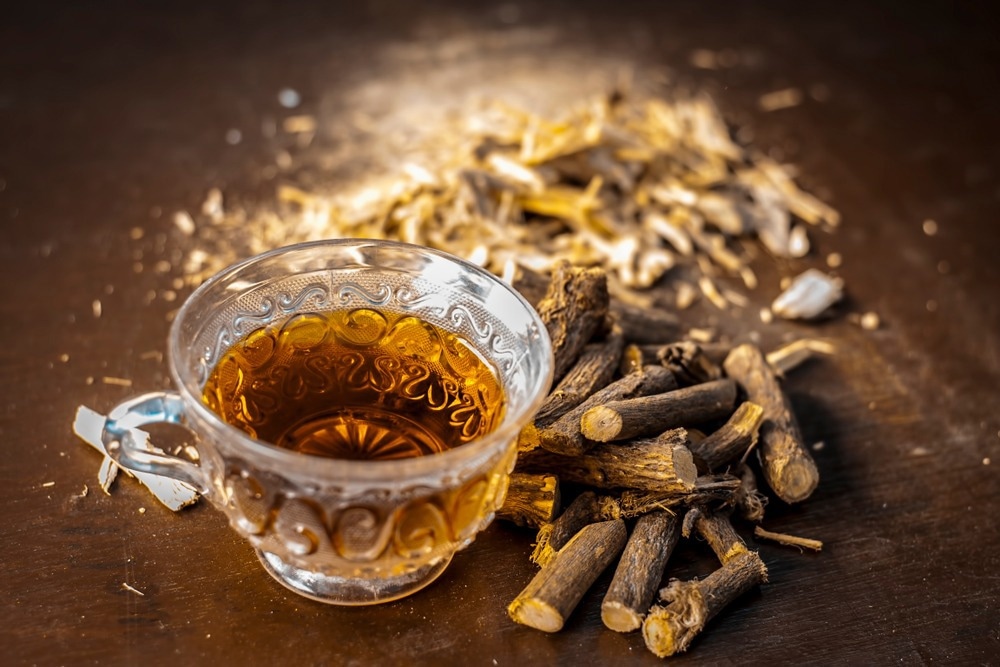Study suggests licorice-derived liquiritigenin has breast cancer prevention potential for high-risk postmenopausal women
In a recent study published in Scientific Reports, researchers evaluated the potential of three licorice (Glycyrrhiza) species, i.e., G. glabra (GG), G. uralensis (GU), and G. infata (GI), and hops (Humulus lupulus), and their main bioactive polyphenols, to prevent breast malignancy.

Background
Breast cancer is the most frequent malignancy in women and also the second greatest reason for cancer-related mortality globally. The risk of breast cancer is the greatest among postmenopausal women. Estrogen-lowering treatments, such as aromatase inhibitors (AIs), including exemestane (steroidal) and letrozole (non-steroidal), help prevent breast malignancies among postmenopausal women; nevertheless, their side effects have decreased adherence and acceptance to interventions.
Substitutes must be functional, less harmful, and more acceptable to women. Licorice and hops, extensively consumed by females for relief from menopausal symptoms, also have chemopreventive and estrogenic properties. However, data on their effects on aromatase activity and cellular proliferation among human breast tissues are scarce.
About the study
In the present study, researchers reported on licorice-derived liquiritigenin’s (LigF) promising potential to prevent breast cancer via inhibiting aromatase and protein synthesis among women at increased risk of breast cancer.
The team evaluated the AI effects of Glycyrrhiza species, hops, and their main bioactive compounds. In silico-type docking analyses were performed by modeling the structures of aromatase, three phytoestrogens, i.e., 8-prenylapigenin (8-PA), 8-prenylnaringenin (8-PN), and LigF, and non-estrogenic molecules such as 6-PN, LicC, XH, and LigA. Their binding affinity was compared to two AIs, exemestane and letrozole.
Microstructures obtained from surgical high-risk breast tissues, comprising myoepithelial, endothelial, and glandular cells and adipocytes, were used to evaluate aromatase suppression by licorice, hops, and their biologically active polyphenols. After observing improvements with the phytoestrogens of licorice (LigF) and hops (8-PN), their uterine safety profiles were assessed.
In vivo experiments were performed using female Sprague-Dawley rats; following LigF’s demonstrated safety in estrogen-responsive tissues such as the uterus of rats, LigF-exposed breast tissue samples of high-risk postmenopausal women were subjected to transcriptomic analysis. The transcriptomic findings of decreased cellular proliferation, as indicated by changes in protein biosynthesis, were verified by performing live imaging of LigF-exposed Michigan Cancer Foundation (MCF)-7 cells.
Results
Among the plant extracts, G. infata showed the highest AI potency, followed by G. glabra, G. uralensis, and hops, with half-maximal inhibitory concentration (IC50) values of one, three, three, and five µg/mL, respectively. AI compounds with nanomolar (Nm) range potencies were the phytoestrogens 8-PA, LigF, and 8-PN.
Among phytoestrogens, LigF, a constituent of all Glycyrrhiza species, inhibited aromatase most potently, as reflected in the computational docking analysis findings of their structural configurations in the aromatase binding pocket. In their most energetic and favorable conformations, LigF and 8-PN were bound to the heme complex. LigF and GI extracts suppressed aromatase levels among postmenopausal women at an increased risk of breast cancer.
LigF demonstrated estrogenic effects in vitro; however, via estrogen receptor-beta (ER-β) activity, LigF (150.0 mg/kg/day) significantly decreased estrogen-induced growth of the uterus in vivo and downregulated ribonucleic acid (RNA) translatory mechanisms, protein synthesis, and amino acid metabolism among breast tissues of high-risk women. Repeated doses of LigF (20.0 µM and 40.0 µM) administered every two days also retarded the proliferation of Michigan Cancer Foundation-7 cells.
Gene Ontology and pathway analysis using databases such as Reactome 2022 and Bio Planet 2019 indicated that LigF significantly lowered the expression of ribosomal protein (RP) genes, eukaryotic translation elongation factors (EEFs), and translation initiation factors (EIFs). In addition, significant downregulation of estrogen-responsive genes such as interleukin-20 (IL20), PDZ and LIM domain 3 (PDLIM3), lysyl oxidase-like 2 (LOXL2), and BARX homeobox 2 (BARX2) was observed.
In contrast, genes related to estrogen-responsive pathways, including trefoil factor 1 (TFF1), progesterone receptor (PgR), growth regulation by estrogen in breast cancer 1 (GREB1), early growth response protein 3 (EGR3), and sushi domain containing 3 (SUSD3), were significantly upregulated. Licorice species, hops, and their main bioactive polyphenolic compounds could inhibit aromatase. Phytoestrogens obtained from licorice and hops were bound to aromatases similar to letrozole. Phytoestrogens have high AI potency, likely due to their binding affinity for the aromatase pocket than the other compounds.
Conclusion
Based on the study findings, liquiritigenin, a phytoestrogen obtained from licorice, may prevent breast cancer among high-risk postmenopausal women, similar to aromatase and cyclin-dependent kinase (CDK) inhibitors, extensively used by women to treat menopausal symptoms without any uterotrophic effects. Botanicals are likely to have greater acceptability among women than pharmacological drugs and, therefore, would overcome the biggest hurdle to the prevention of breast cancer.
- Hajirahimkhan, A., Howell, C., Bartom, E.T. et al. Breast cancer prevention with liquiritigenin from licorice through the inhibition of aromatase and protein biosynthesis in high-risk women’s breast tissue. Sci Rep 13, 8734 (2023). doi: https://doi.org/10.1038/s41598-023-34762-z https://www.nature.com/articles/s41598-023-34762-z
Posted in: Medical Science News | Medical Research News | Disease/Infection News
Tags: Adipocytes, Amino Acid, binding affinity, Breast Cancer, Cancer, Cancer Prevention, Cyclin-dependent Kinase, Drugs, Estrogen, Gene, Genes, Hops, Imaging, in vitro, in vivo, Interleukin, Kinase, Metabolism, Mortality, Progesterone, Proliferation, Protein, Protein Synthesis, Receptor, Ribonucleic Acid, RNA, Sushi, Translation, Uterus

Written by
Pooja Toshniwal Paharia
Dr. based clinical-radiological diagnosis and management of oral lesions and conditions and associated maxillofacial disorders.
Source: Read Full Article



